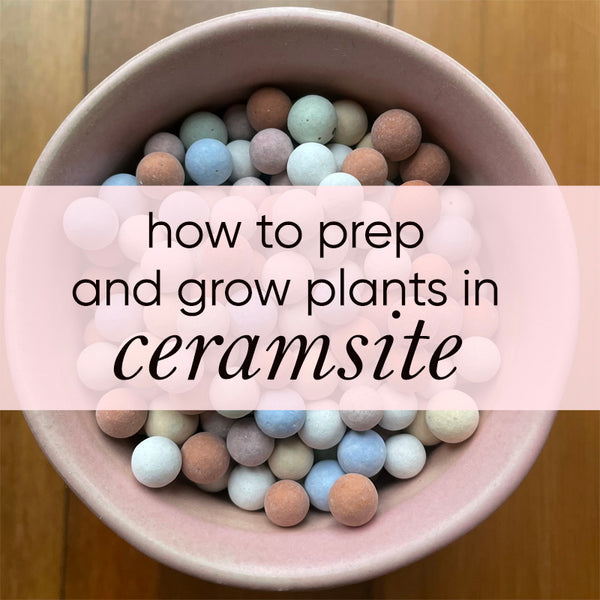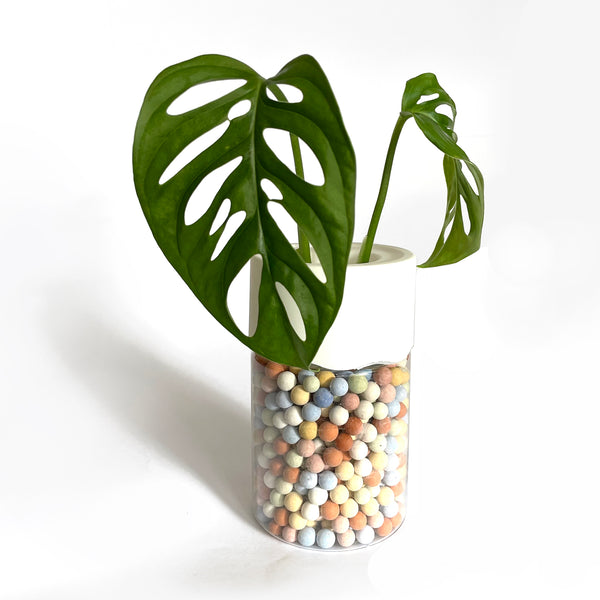How to use Ceramsite for indoor plants
I call ceramsite 'baby leca' although houseplant hobbyists often use leca and ceramsite to describe the same thing. These two plant substrates are essentially are the same, with more similarities than differences, although the prep before use is slightly different (prep and more tips coming up).

Amazon links in this post may be affiliate links which means I may receive a commission for purchases made through links. I only recommend products that I have used myself. Learn more
Both leca and ceramsite are popular plant substrates for semi-hydroponics, often used in self-watering and wick-watering pots, or in containers with a water reservoir at the bottom.
Leca is the name you'll often hear used for the less regular-shaped, round'ish balls of brown clay, whereas ceramsite is normally the name given to the often smaller, typically multi-coloured, smoother round balls of clay. Both can vary in size but in general, leca tends to be brown, larger and rougher, and ceramsite multi-coloured, smaller and smoother.
Both are made of fired clay, are natural, soil-free, very long-lasting and reusable. Both reduce the risk of root rot and of soil-loving bad bugs like root mealy and fungus gnats setting up home in your plants.
Leca and ceramsite can also be used as an additive mixed in with your potting mix, as a top-layer on pots, or a bottom drainage layer. Another popular use is to make a pebble tray for humidity, adding a layer of ceramsite (for smaller saucers), or leca (more popular for larger saucers) in a saucer or tray, then adding water 3/4 of the way up the clay balls. You sit pots on top, but maintain the water level below the bottom of the pot, so rather than the plant absorbing the water, the water evaporates naturally over time, increasing ambient humidity around your plants.
How do you prepare ceramsite before first use?
Similar to leca, ceramsite should be soaked and rinsed before first use BUT unlike leca ceramsite tends to need fewer rounds of soaking to get out clay silt out and the water in. However, it's HOW you soak ceramsite that's the main difference to how you prepare leca.
Your ceramsite will arrive dry. The colours will be more pastel-looking than the photos you see of ceramsite when wet, so expect the colours to be different than you may have seen on your computer or phone.
STEP ONE - SOAK
As the holes in ceramsite are a lot smaller than leca, drip-soaking is better for prepping ceramsite. Where you might put your leca into a bucket or sieve and run the hose or tap on full to flush out the silt, it's best to take it more slowly with ceramsite.
Pour the amount of dry ceramsite you need in a container that doesn't have drainage. With the tap on the lowest amount you can, slowly fill up the container, drip by drip. This slower approach allows water to get right inside the ceramsite balls rather than trap air inside. Trapped air reduces the water-wicking ability.
STEP TWO - REPEAT & RINSE
Do a drip-soak twice, tipping the water out in-between. You can either then give it a good rinse and use your ceramsite now, or do a third soak but this time in a nutrient solution. I just add my usual amount of fertiliser to the water and let the ceramsite soak in that for about an hour (for the optional third soak you don't need to drip-soak, you can just pour the nutrient water in).
The same as leca, ceramsite has no nutrients. It's up to you to provide your plant with the nutrients it needs. With both leca and ceramsite, you want a complete and balanced fertiliser that's made for hydro and semi-hydro (not all are). My favourite is the Growth Technology range (if you're not in New Zealand, you can also get GT here on Amazon). There's a big range to choose from but I mainly use GT Foliage Focus. If you can't get GT locally, another option rated for hydro and semi-hydro, is the Dyna-Gro range. For my international plant friends, their best-seller is available here Dyna-Gro Foliage Pro.

How do you fertilise when growing in ceramsite?
It's important to add a hydro or semi-hydro fertiliser every time you water, whether you're topping up or fully replacing the water in the reservoir. If you top-water or bottom water instead, water as usual with fertiliser included.
Even if you choose a low-salt fertiliser that's free of urea, chlorides and sodium (like Growth Technology, available here in NZ or here on Amazon), you should still add an occasional flush rinse with plain water every month or two. I just run plain water through the container until it overflows, then tip out the excess. Choosing a low-salt, complete and balanced fertiliser like GT does reduce the risk of root burn from excess fertiliser salts, but minerals in your water supply, and un-used minerals in your fertiliser can still build up slowly over time.
What is ceramsite made of?
The type of ceramsite we use for indoor plants is clay ceramsite. Clay ceramsite is natural, made from balls of clay that are kiln roasted until they expand, creating a porous honeycomb texture inside. The colour of the clay combined with the firing used determines the final colour, ranging from shades of terracotta from brown to orange, yellow, eggshell white, shades of blue, pale sage and tawny-pink.
What's the benefit of using ceramsite for plants?
Being round yet tough, ceramsite does not compact or breakdown over time, maximising space for oxygen. More oxygen equals happier roots. No soil also means less chance of getting soil-loving baddies like root mealy and fungus gnats. The wicking ability of clay combined with the porous, round shape reduces how much water it holds, also reducing the risk of root rot. Even when wet they are more air than water.
Can you re-use ceramsite?
Yes, like leca, ceramsite can be re-used again and again. It won't decompose or compact. You can wash and reuse it. Some growers boil their used ceramsite between plants to sterilise it. Another option is to soak it in plant-friendly hydrogen peroxide to sterilise and clean between plants. For those in New Zealand I use Oxygen Plus 3% for Plants, or for my international plant buddies, grab yourself some Essential Oxygen 3%.
What's the difference between leca and ceramsite?
Leca and ceramsite have more similarities than differences. Both are popular for semi-hydro for plants, most often used to entirely replace potting mix used either in a self-watering pots or with a water reservoir at the bottom with or without a wick. Both are also used an a soil amendment to reduce water-holding capacity and increase air space. Ceramsite is often added as a top layer over leca to reduce water loss. Due to its size, ceramsite is also the more popular of the two for finer-rooted babies and mature plants with delicate or smaller root systems, although smaller leca sizes are becoming more widely available for that purpose too.
How can you use ceramsite to get rid of fungus gnats?
Some growers first find out about leca or ceramsite when researching ways to avoid fungus gnats, possibly the most annoying indoor plant pest. It's true a lot of pests are less likely to set up home in plants grown in leca and ceramsite, but it's not guaranteed you'll never have pests again as some are all about the foliage, not the soil. As ceramsite tends to be smaller than leca, one method to reduce the risk of fungus gnats is to add a layer of ceramsite over the top of your plant's soil. Just keep in mind it'll need to be at least a few cms deep.
More about leca...
As leca and ceramsite are essentially the same, if you want to know more about both, have a look at the ultimate guide to growing houseplants in leca > next, which goes into detail about where the water level should be, preventing root rot, getting rid of algae, maintenance during the first month and more.
